Leopard 50 owner’s review
Owner’s Review: Leopard 50 Catamaran
A big thanks to Tony for helping us with this Leopard 50 Owner’s review. There are some fantastic insights here if you are looking at Leopards or any other cruising cat for that matter.
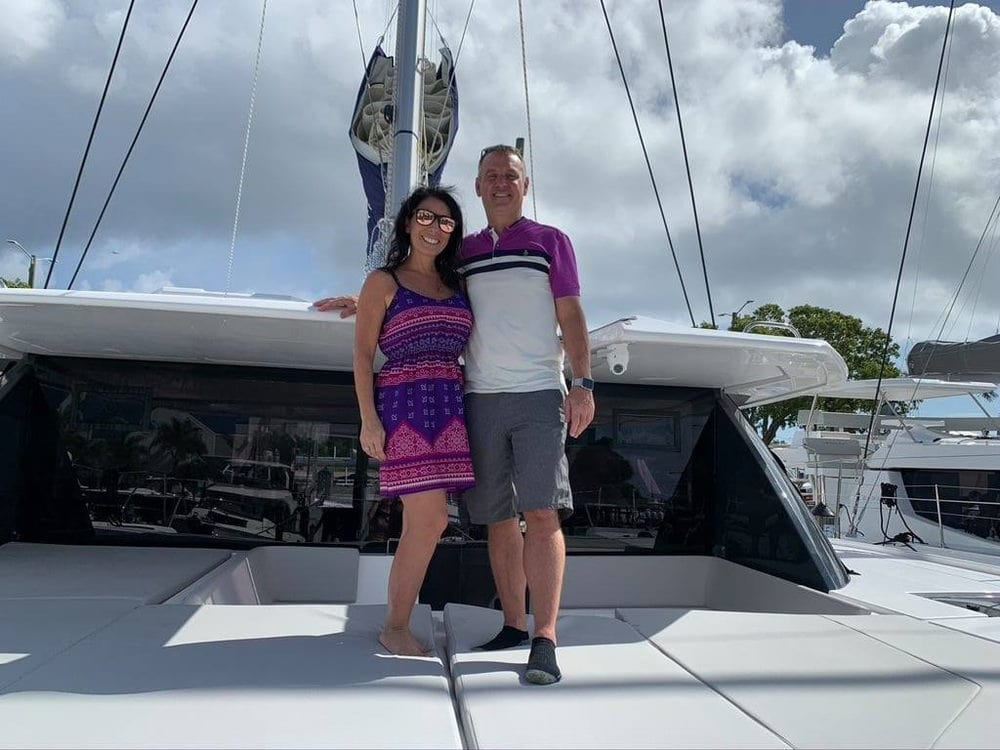
Can you tell us a bit about yourself and your boat, Dracarys.
I’m a 52-year-old business consultant that recently became an empty nester. After selling my business in 2014 and more recently sending my two youngest children off to college, I decided that it was time for some adventure travel.
Since I consult remotely, I placed my order for my Leopard 50 sailing catamaran in October of 2020 and took delivery in September of 2021. The name, “Dracarys” (pronounced “Druh-KARR-is”), is a Game of Thrones reference, and yeah, most people don’t get it – but those who do are enthusiastic about it!
Dracarys is my first sailboat, and to date, I’ve taken her 14,000nm, including multiple trips between the Gulf side of Florida and the Chesapeake Bay, Mexico, and the Exumas. I ordered her after gaining a grand total of about three weeks of sailing experience – one week of ASA classes and two charters in the BVI. The largest boat I’d owned previously was a 23-foot wakeboarding boat.
https://www.tiktok.com/embed/v2/7044981426986585350?lang=en-GB&referrer=https%3A%2F%2Fwww.katamarans.com%2Fowners-reviews%2Fleopard-50-owners-review%2F&embedFrom=oembed
Why did you choose the Leopard 50? Did you look at any other catamaran brands?
I seriously considered several production catamaran brands: Leopard, Fountaine Pajot, Lagoon, Nautitech and Bali. Each brand has its unique features and configuration differences, each with their own appeal.
In my final analysis, the features that I valued most pre-purchase were:
1) The helm location situated between the bridge deck and the upper lounge provides excellent visibility, is easy and safe to access from the salon/cockpit, provides easy access to the deck, and allows me to easily communicate/ socialize with companions in the salon, aft cockpit, or upper lounge.
2) The forward hatch (or “front door” as we call it) allows for convenient and safe access to the foredeck and provides excellent ventilation.
3) The forward cockpit provides an additional living area at anchor, and a safe location to experience being forward in rough seas.
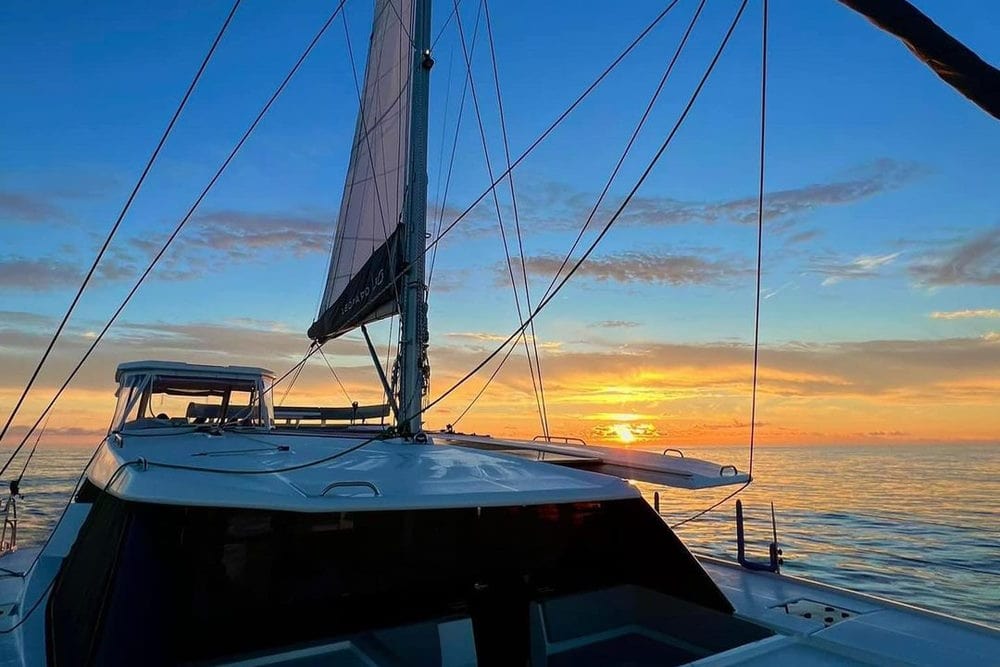
After a year aboard, I feel that these three features are even more valuable to me than I thought they would be. The ability to easily and quickly move between the helm and salon, and between the helm and deck is a convenience that I’d never give up. I find that I spent much less time “at the helm” than I expected I would (thank you autopilot), and the ability to easily grab a drink, use the head, adjust a fender, or run to the bow to enjoy the dolphins is a “must have”
for me.
Likewise, the “front door” makes the entire forward area of the boat easily accessible. I can’t imagine having to exit the salon aft, walk along the side deck, do whatever I need to do, and then reverse that process each and every time I want or need to go forward.
Another consideration in my brand decision was, of course, build quality. I certainly have no expertise in boat construction, however, to a layman, everything on and in the Leopards feels solid. The rig, cleats, stanchions, hatches, doors, cabinetry, cushions, fixtures, etc., all felt “beefier” than the analogous items on the other brands.
One brand had caulk joints wider than my thumb throughout. On another brand, the veneer on the cabinets was already chipped and flaking at the edges on a brand new boat after just a few days of boat show traffic.
Maybe because so many Leopards are built to withstand charter use and abuse, they appear to my eye to be built to a higher standard.
Regarding size, I really struggled over the decision between the Leopard 45 and 50. I was initially intimidated by the size of the 50. But the difference in living, galley, and storage space and the knowledge that the larger boat would be more comfortable in big seas eventually won out. Thankfully, the intimidation factor disappeared after a couple of weeks and I’m extremely happy that I went with the larger of the two models.
When was she launched?
She arrived in the US in August of 2021 and I took delivery in early September.
What’s the best thing about her?
I’ll answer that the same as if asked about any other lady: “Everything”
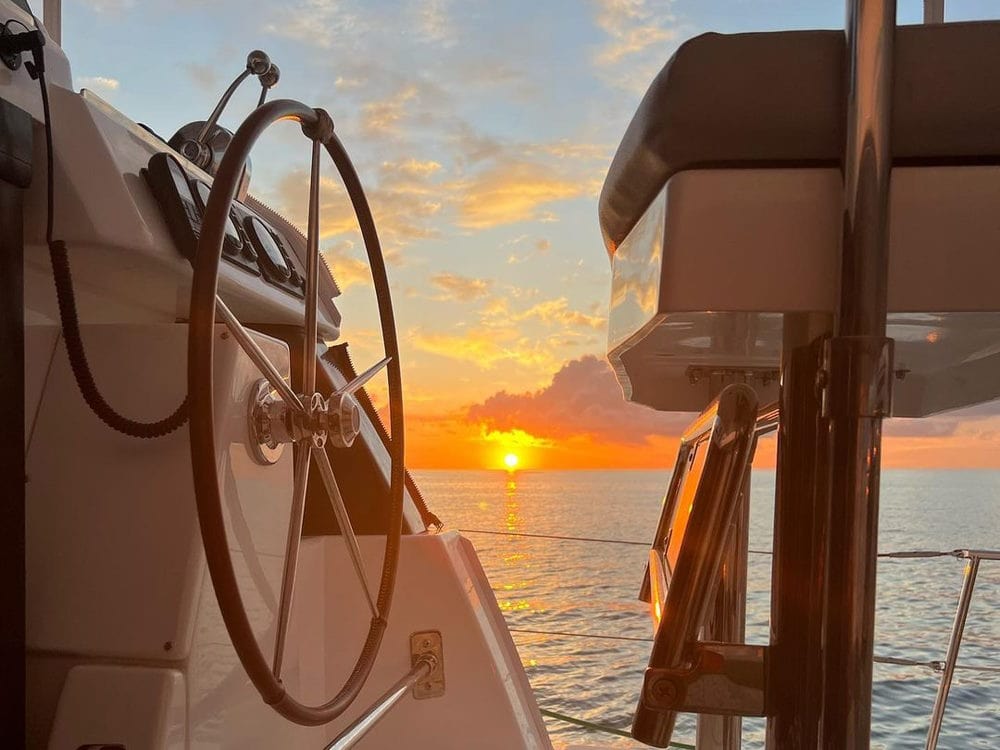
What would you change if anything?
I selected the four-cabin version and if given a do-over, I would select the utility room option in lieu of the fourth cabin – it’s become a de facto utility room anyway.
There are a couple minor annoyances:
1) the refrigerators/freezers have an “off” button on the front panel that sometimes accidentally gets pressed. Who wants an “off” button on their fridge?
2) Also, the boat is delivered with all galley outlets on a single 20-amp breaker, which is probably fine for charter. However, after I added an induction hotplate, microwave, Breville oven, Starlink, computers, etc., I was tripping that breaker daily. But this problem was easily and inexpensively resolved by Just Catamarans by added a few more dedicated 20-amp circuits to the galley to accommodate my power-hungry lifestyle.
3) In a “wave a magic wand” world, I would have loved to have had the option to have the starboard hull configured like the Leopard 45 owner’s version. It could be a massive owner’s suite with a sitting area apart from the salon.
What are the “Must Have” Options buying new in your opinion? eg square top mainsail, engine upgrade, folding props, Gas BBQ , A/C, heating, watermaker, bowsprit, gennaker, code 0 inverter, solar, gen set, washing machine etc….
I think the engine upgrade (to 80hp turbo-charged Yanmar 4JH80s) is a no-brainer. I’ve never felt underpowered, but I’ve sometimes wondered how the smaller engines would feel going through tight drawbridges with a strong opposing current.
For me, air conditioning is a lifestyle must-have; I’m not one to tolerate sweating in bed. In addition to staying cool (or warm), having air conditioning allows me to close all the doors, windows, and hatches to keep mosquitos and no-see-ums outside where they belong!
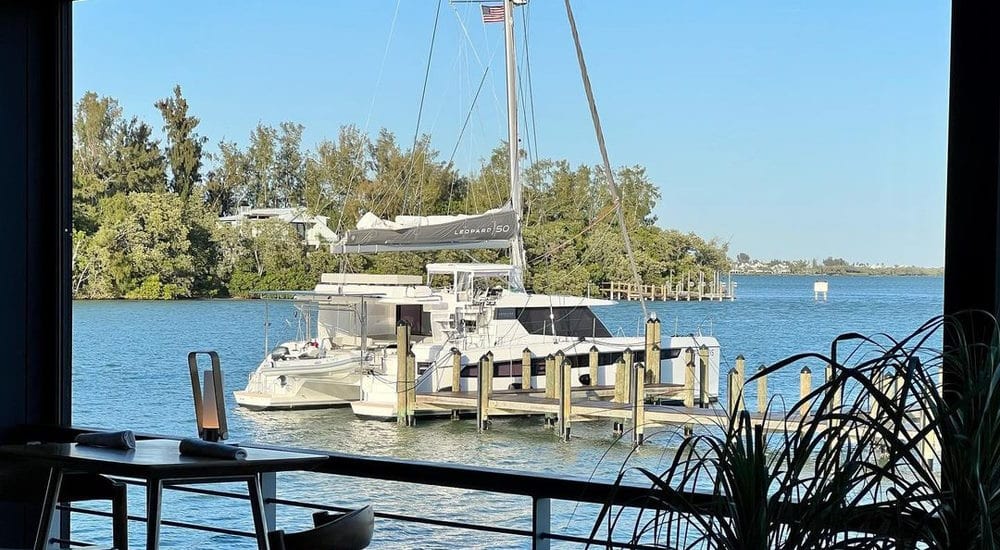
I kept the stock props for about 2,000 nm just so I would fully appreciate the spend for the feathering Maxprops. I absolutely love the Maxprops and would put them high on my list of must-have aftermarket options. I estimate that I’ve picked up an additional knot (or very close) under sail, and since the prop/transmission doesn’t free-wheel, there’s zero noise (or transmission wear) under sail.
A generator, lithium-ion batteries, solar panels, a water maker and washing machine are also
must-haves for my lifestyle. I like the comforts of home (Condomaran?) and anything that makes providing my own utility services easier makes life better.
I opted against the square-top mainsail and I’m glad I did. I know some who have it and wish
they didn’t – reportedly, it can be finicky.
What do you have in your sail locker?
I currently have only the stock sails. I ordered the boat rigged for a bowsprit but didn’t purchase a sail because I had no idea which kind of sail I might want.
14,000+nm later and I’m still undecided. I get conflicting opinions from other owners, so I’m convinced it’s very much a personal preference thing – I just don’t know mine yet.
What are the “Nice to Have Options”?
I’d put the faux teak option in the “nice to have” category. It looks great but comes with some drawbacks: it’s expensive, heavy, and can be hot on bare feet. I opted against the factory faux teak thinking that I’d install one of the cooler options, but I’ve found that I don’t often wish that I had it, so I doubt that I’ll move forward with it.
I think underwater lights also solidly fall into this category. Expensive, yes, but they really set the ambiance at anchor.
Which options are not worth bothering with?
Many are sure to disagree, but for me, the dinghy lifting platform is one that I easily live without. It was a $50,000 upgrade at the time of my purchase, and I just didn’t see the advantage. It’s a lot of weight on the stern, and since it can accommodate more dinghy weight than the davits, a heavier dinghy choice adds even more weight.
Also, though I’ve not done it myself, I’ve often wondered how hard it is to position the dinghy on the platform chocks in rough water.
Though I didn’t order it from the factory, I was so convinced that I’d want the wireless remote helm control unit that I purchased it and installed it myself. As it turns out, I don’t think I’ve used it since the day that I tested it.
On a friend’s suggestion, I did not order any interior blinds from the factory and instead installed cellular aftermarket blinds. In my opinion, they look much nicer, and without question, they make a huge difference in keeping the interior temperature down. Pricey, but I think worth it.
How are the electrics, plumbing etc
With the exception of the entire salon/galley being on a single 20-amp breaker, the electrical system is good, and I’ve had no issues. I ordered the second 3,000W 120V inverter option from the factory and then added a Victron Quattro for 5,000W of 240V inversion capability.
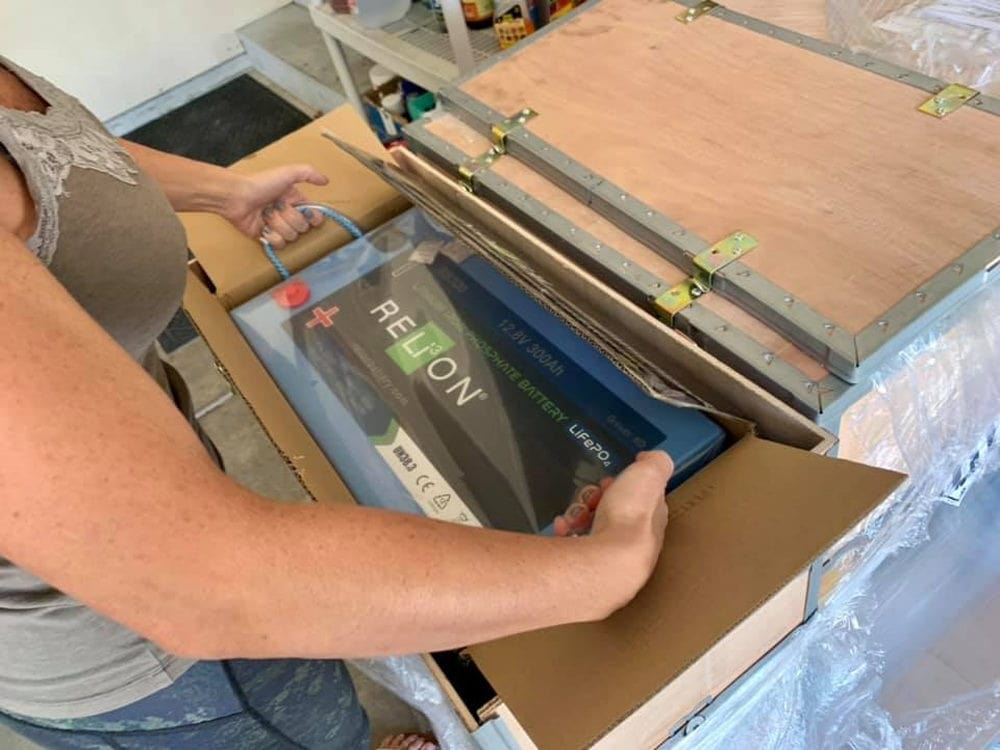
With an 1,800 Ah Lithium-ion battery bank, I can usually run the air condition off battery (on eco mode which works great) for the entire boat all night, depending on ambient air temperature.
I’ve had no issues at all with supply or waste plumbing. Some friends “dog bag” their toilet paper rather than flush it. I chose to gamble and not do that.
Luckily, I’ve had no problems at all (where’s the wood to knock?!). After about 10 months of nearly full-time use, I noticed a small amount of backflow into the toilet bowls, so I had to tackle the dreaded backflow valve cleaning/replacement.
It turns out that it was not a nasty job at all. Ok, maybe a little bit nasty, but still better than the Crossfit-like workout misery of putting sheets on the beds!
Is she easy to maintain? Servicing engines, standing rigging etc
Maybe because so many units are produced for charter, everything is accessible. Some areas take more effort than others, but you can access everything.
I’d put myself in the “heavy DIY” category of owners – I’ve run cables throughout the boat, added lighting, installed motorized TV mounts, computer monitor swing-arms, glassed in backing for fishing rod-holder mounts (on friends’ boat).
I think I’ve been in every nook and cranny it has, even if just to see what’s there. Every space has an access panel – sometimes you just have to look carefully for it.
My height (5’7″) is sometimes a blessing and other times a curse. I can fit into small places, but sometimes I wish my arms were just a bit longer.
The engine compartments are spacious, well lit, and have safe access when underway. Some sticky-backed foam padding in key places has saved my skull more than once. Note that it took a couple of swear-word-filled events to figure that out.
The only thing that’s not easy with regard to maintenance is….cleaning! Cleaning is a never-ending job, and sometimes I think about the day that I chose the 50 over the 45! There’s a lot of
boat to keep clean.
Is she easy to sail short-handed? To shorten sail? Easy to reach the boom?
I have all lines run back to the helm with the exception of the lazy jacks, genoa halyard,
and topping lift (none of which I use often), so sailing short-handed is easy.
I’m short but agile, so the boom height isn’t a big issue for me. I had a few extra steps/handholds added to the mast and I can reach the rest of the sailbag zipper (I added a string to it) from the top of the helm roof.
I recently replaced the main halyard with a stronger, less stretchy, smaller-diameter line than the stock halyard. This lets the sail drop more freely than it originally did, though I also added a downhaul that is run back to the helm as an extra measure.
What’s she like in heavy weather / a blow / big seas
The most severe weather I’ve experienced so far was a on a sail from Key West to Sarasota – about 30 hours. There was a small craft advisory issued; winds and waves were at about 50-60 degrees off the nose at around 30kts and nine feet, respectively.
To me, she felt like a bulldozer running through marshmallow fluff. I don’t have the experience to know if that’s normal, but I was very pleased! There was minimal creaking and banging. Overall, the boat gave me the impression that she didn’t even notice the conditions.
How is the helm position. OK to sail short-handed?
As mentioned, the helm position was an important factor for me in my buying decision. I
appreciate the convenient and safe access, and the visibility is excellent.
Other than throw lines when docking, I operate the boat by myself without any problem.
The visibility is excellent for open-water navigation. The lounge seats create a bit of a blind spot to the port aft quarter, but the gap between the horizontal seat cushions and the seat backs provides enough of a visibility gap to check for traffic.
For docking, my height is a disadvantage for seeing the port bow, however, I’ve solved that
problem with a fishing rod holder mounted vertically on the port bow railing that holds a boat
hook.
Also, standing on an aftermarket footrest on the helm seat provides a better view forward for shorter people like me. View of the port sugar scoop from the helm is blocked by the cockpit roof, but here my size is an advantage; I don’t have to bend down quite as much to put eyes on it.
How does she sail in light winds?
I’m running just the stock main and genoa – I have no light wind sails – so light wind
performance isn’t fantastic. I’m looking forward to adding some light wind sails soon.
How does she sail close hauled? What TWA or AWA is the sweet spot in 12 knts of breeze for example?
My sail trimming skills are…developing, so my answers to “how does she sail” questions probably reflect more on the operator than the boat. With my current sails, I’m not likely to pinch in light winds.
I usually have tide and/or daylight conditions I’m trying to optimize at my destination, and I plan my routes assuming 5kts VMG – if I’m not making that, I turn on an engine. The 14,000 miles I’ve put on her are about 60% sailing, 40% motor/motorsailing (I’m not a sailing purist).
The last photos I took show me making 7.7kts through the water in 20kts of apparent wind at 40 degrees AWA, and 8.4kts through water 70 degrees AWA in the same wind, calm sea state.
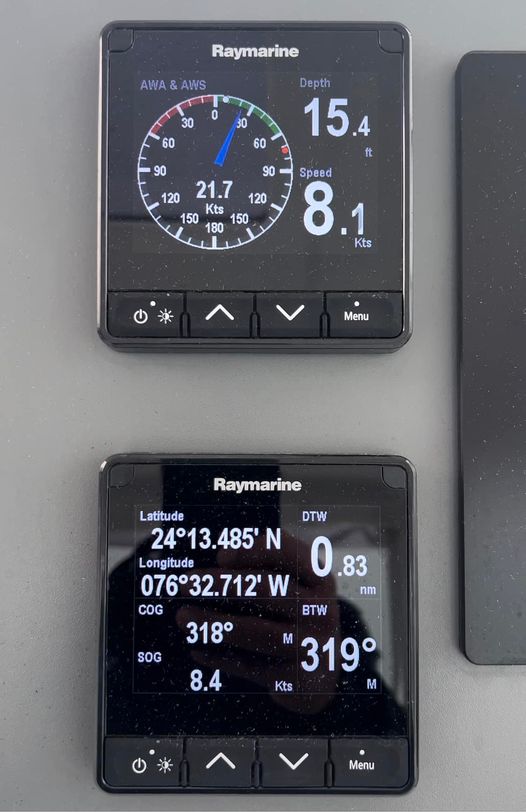
What’s she like under power? Speed, manouevrability?
With a 26.5’ beam, she pirouettes in place within her own length – it’s like driving a zero-turning-radius lawnmower. Underway and using rudders, the helm is very responsive; when I want to turn, she turns. I was initially intimidated by her size and seriously considering adding a bow thruster to assist with docking, however, after just a bit of practice, I feel that having one is totally unnecessary.
With the 80HP engine upgrade, I have yet to feel underpowered.
Is she easy to dock, what’s the visibility like? Do you have a bow thruster?
I previously mentioned my height challenge with seeing the port bow and my rod-holder solution (along with someone calling out distance to the dock). There is maybe a time or two that I might have used a bow thruster if I had one – those “You want me to dock THERE?!” situations – but in general I think it’s unnecessary.
The differential thrust from the engines and the amply-sized rudders give me a very positive feel of control while docking. Note that I hired a training captain for my first two weeks of operation who ran me through the docking exercise grinder, and I’m glad he did.
What is she like at anchor? Does she sit well? That forward cockpit looks good for a sundowner.
When rigged for a bowsprit, the bridle must fit under the bobstays. Necessarily, this creates an obtuse angle where the legs of the bridle combine to the portion of the bridle that leads to the anchor chain (think of a Y that looks closer to a T if you were viewing the boat from the anchor location.) This geometry allows the boat to pivot in place nearly forty-five degrees in each direction off center; so about ninety degrees of pivot even in light wind.
Note that this is pivot/yaw, and not swing, but it makes you feel like you’re swinging. It’s a bit annoying but I understand the necessity of the bridle design. For longer stays in a location, I solved this yaw problem with a Mantus bridle that I attach to the bow cleats (not the cleats on the crossmember between the hulls).
The forward cockpit is great spot for dinner for two, but for me, the best place for a sundowner
is on the upper lounge which supplies a three hundred sixty-degree view!
https://www.tiktok.com/embed/v2/7177439867020840238?lang=en-GB&referrer=https%3A%2F%2Fwww.katamarans.com%2Fowners-reviews%2Fleopard-50-owners-review%2F&embedFrom=oembed
What type of anchor/weight/chain length did you go for?
I chose a Rocna 40kg (88lb) anchor – I think it’s the largest/heaviest anchor that fits without modifications to the anchor roller/mount area. For chain, I went with 240 feet of Maggi 10mm. Why a random number like 240 feet? Because that’s what was available.
What kind of dinghy/power unit did you go for?
I chose a Highfield Classic 360 with the FCT steering console and seat, powered by a Yamaha 25HP 4-stroke with power tilt. I opted for the davits rather than the lifting platform and this dinghy configuration is within the load limit.
Is she comfortable down below? Cabins/saloon/galley/heads.
My smaller stature is an advantage for getting comfortable on any boat. Nonetheless, I think the Leopard 50 is spacious and thoughtfully laid out. The cabins live well, the galley layout is great, and the nav desk makes a great workstation.
The owner’s head is reasonably spacious, but a little tight for two people to use to the sink area at the same time.
Some other brands have a separate toilet room and double sinks, which would be great, but every boat is a compromise.
What configuration is Dracarys? Owners? Did you go for the utility room?
I have the four-cabin version. If given a do-over, I’d get the utility room option.
Where’s your favourite spot on the boat? Up top on the lounge? Aft? Forward cockpit? Do you use the flybridge while under way in calmer conditions?
I have a few favorite spots. I probably spend the most time at the nav desk when not underway. I chose to not order the optional television at the nav desk. The space to accommodate the TV and electric mount is created by moving the nav desk six or eight inches aft. This pinches the space between the nav desk and the companionway railing a bit too much for my liking.
Without the TV option, the space between the desk and railing allows for a swiveling and reclining office chair (not a high-back “executive” chair – just regular back). There are non-skid feet available on Amazon that I installed on the chair in lieu of the casters. This chair and a long, heavy-duty swing mount for a computer monitor makes for a comfortable workstation.
I definitely enjoy the upper lounge while underway as well as the bow seats. I’ve been known to tether myself to a bow seat in bigger seas so that I could dip my toes as I “ride the bull”.
Maybe an uncommon spot where I spend a significant amount of time while underway in milder conditions is on top, directly in front of the mast. Standing there, just leaning back against the mast offers a great view and I really feel connected with both the boat and the environment there.
How is the finish of the interior? Does she creak under sail? How is the storage on the boat?
I’m very pleased with the interior finish. The casework is well-constructed, covered with thick and textured Formica that has showed absolutely no wear with over a year of near constant use. The caulk joints are very thin, especially compared to some other brands. My dad always said, “Caulk covers incompetence.” The thin caulk joints on this point tell me that the manufacturing tolerances are tight.
Noise under sail is minimal. There is no noticeable creaking, however, the pins that hold the sliding salon door and sliding window in position have just enough play in their receivers that it creates a faint clicking with side-to-side motion. The fact that that is the most noticeable noise while underway is indicative of how quiet the boat is otherwise.
Occasionally, some gooseneck or boom vang squeaking noise gets transmitted down the compression post into the salon, but not often.
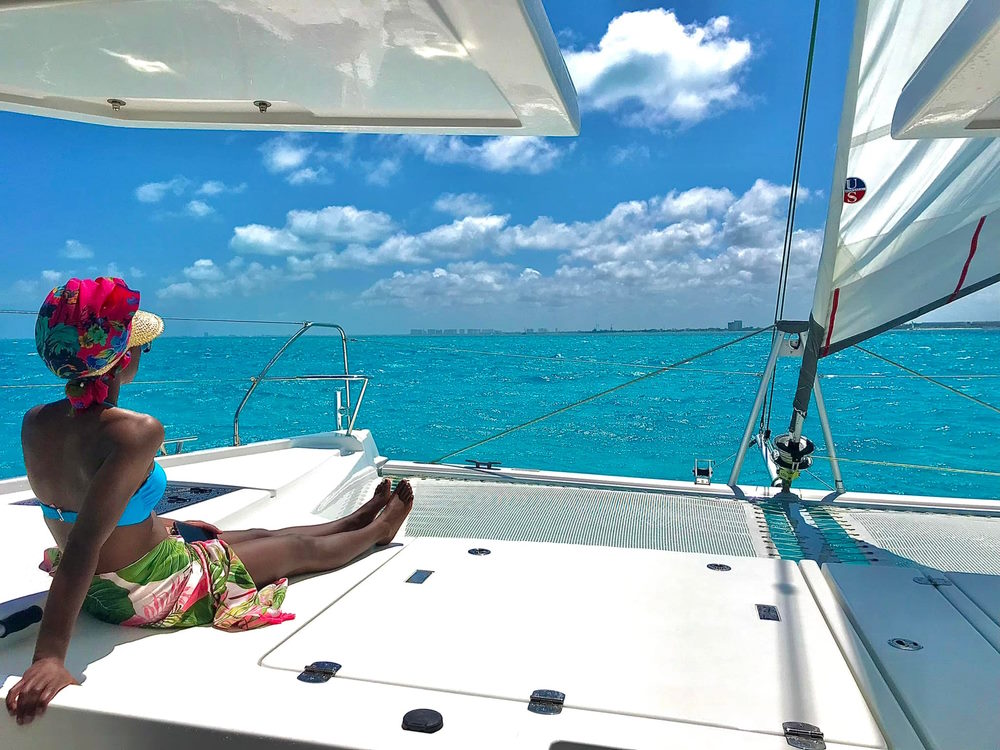
Is she good for hosting guests? How is the galley layout? Nav station? Are there enough fridges/freezers
Hosting is a dream. I’ve comfortably sat dinner for eight at the salon table utilizing the two movable stools placed at the open end of the table. Swinging my monitor out of the way, I was able to seat another at the nav desk.
The galley layout allows for two people to cook with only beginner-level dance skills required to
navigate around each other. I opted to not order the built-in ice maker because it consumes a
tremendous amount of what would otherwise be cabinet space.
I’m very happy with this choice. I have a countertop ice-maker that easily keeps up with the needs of four guests. I located it on the counter area just forward of the compression post (left of the sink) and hid the power cord by running it through a grommet that I installed in the counter.
The other reason I like this solution is that if the ice-maker fails, I have a backup unit on hand (they’re only $100.)
I can’t have a backup on hand for the built-in unit and not having ice is just not an option!
How do you manage power consumption vs power use when at anchor or sailing? Do you have a gen set for example?
The Leopard 50, when outfit for long-term cruising and the comforts of home, is a power hog.
As I’m writing this, I’ve been at anchor for five days. The weather has been perfect and I haven’t needed, or even wanted to run the A/C. Otherwise, living my normal power-hungry life of induction cooking, laundry, computers, etc., my Victron system is showing my daily power consumption is between 13 and 18kWh, of which my solar array has provided 4-5kWh each day (Florida in December).
With that daily deficit, and starting with around 25,000kWh in lithium ion battery power (six 300Ah batteries at full charge), I can get by running my 9kW generator every other day. The generator provides far more power than my charging system can handle, so I also use the generator time to run my water heaters which keep the water hot enough for a hot shower for about twenty-four hours after they’ve shut off.
Note that running high draw systems like air conditioning and/or water heaters off of battery requires running the generator daily.
Under sail, the same conditions exist apart from motor-sailing (or pure motoring) which uses the closed loop on the engine to heat the water in the water heaters.
At a dock with shore power, turn everything on baby! It’s like living at home.
What kind of modifications have you done and why?
The majority of my aftermarket modifications have been comfort and livability related. I’ve done things like add a motorized television mount to the owner’s cabin ceiling, installed color changing LED light strips, and added Starlink (what a game changer!), and added shelves in the unused space over companionways.
Any plans for further customisation?
Not at this time, but I won’t surprise myself if that changes.
If you were to swap her for another boat, what would that be? Or maybe you wouldn’t
swap her?
I can’t think of another sailboat, anywhere in the same price range that I’d prefer. Maybe when my long-distance passage-making itch is scratched, I could see myself in 50-55’ motor yacht. I like the Absolute Navetta line.
How was the buying process with Leopard or their dealer?
The buying process was uncomplicated and, for the most part, smooth. There’s an options changes “lock out” date that wasn’t communicated to me up front, so that created a tiny amount of stress, but all ended well. No question that I’d buy again.
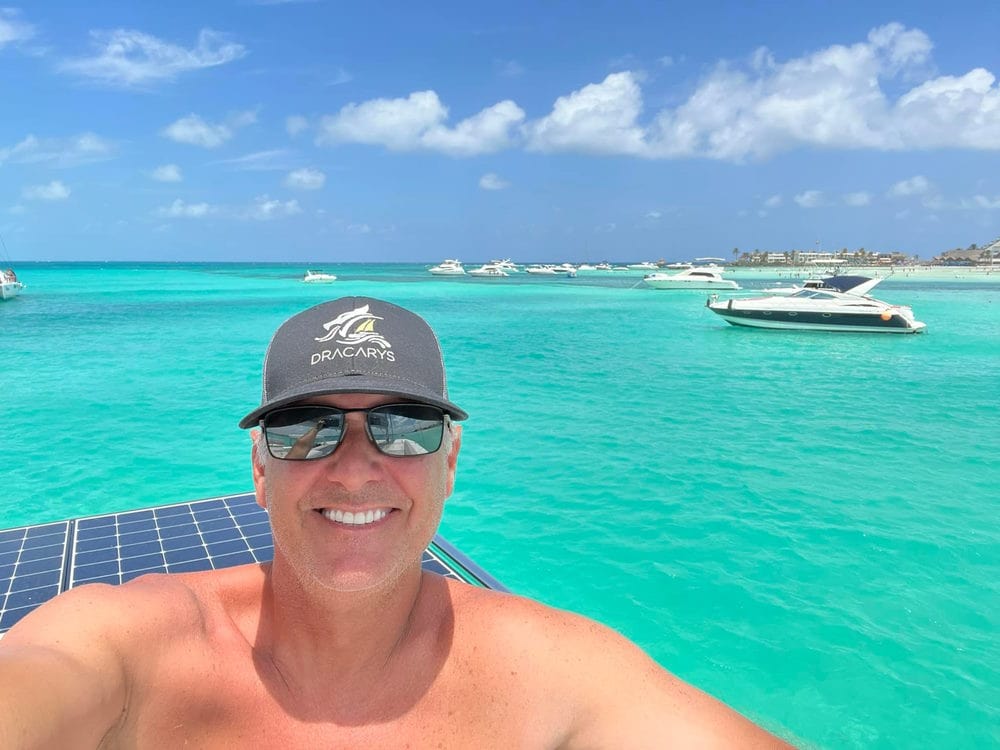
How is the after sales service from Leopard or their dealers? Have you had to fix much?
There’s always something with boats.
For a low-volume production item this complex and one with so many systems, I’m astonished at how few problems I’ve had and their insignificance.
I had a cabin door latch that wasn’t installed correctly and a lazarette catch that was broken on delivery. There were a few other minor items that needed addressed when it arrived in the US from the factory, but all were addressed promptly by the dealer before handover.
Warranty claims were previously handled by the salespersons, who let’s face it, have other priorities. Leopard has recently implemented a dedicated department for warranty claims and I can’t praise them enough for it. I just recently realized that my AC chiller unit was installed such that that zinc was inaccessible. I paid to have the unit moved an
inch or two and was promptly reimbursed by Leopard.
Anything else you would add to help people thinking of buying a Leopard 50?
If, like me, you’re intimidated by the size of the L50, don’t be. It handles easily both under both sail and power, and the extra space and comfort in bigger seas is amazing!
Follow Sailing Dracarys
Thanks, once again, to Tony for this fantastic review. I’d mark this one down as one of the top responses we have had in our owner’s review section, it’s full of insights and tips on the Leopard 50.
Facebook: SailingDracarysOfficial,
Instagram: @SailingDracarys
TikTok: @SailingDracarys

